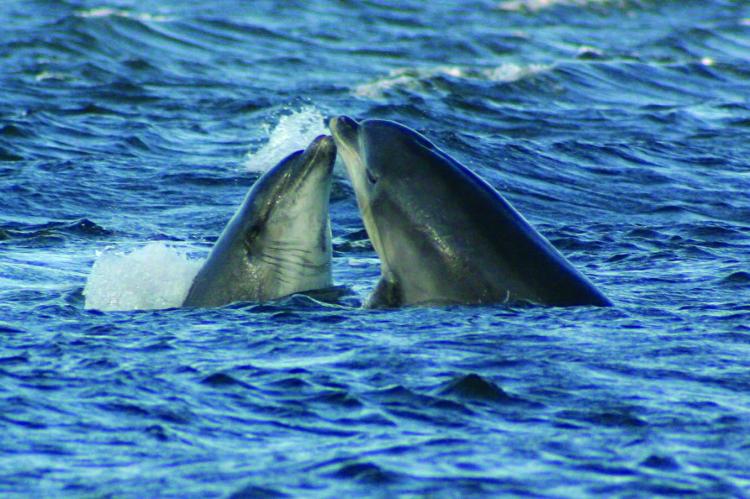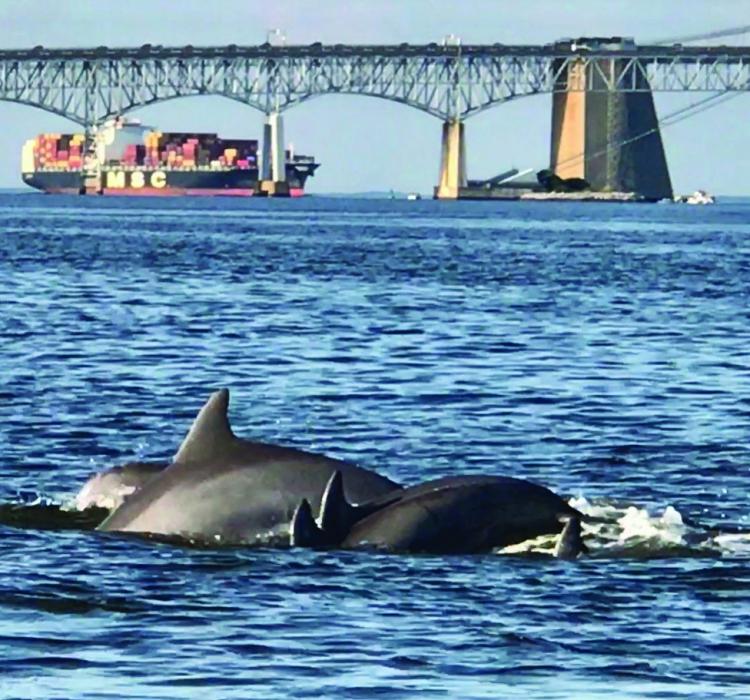Spot a Dolphin? Report It!
When you think of the Chesapeake Bay, you think sailboats, crabs, nettles, and rockfish, but few people think bottlenose dolphins. Dr. Helen Bailey and her team at the Chesapeake Dolphin Watch hope to change that.

It all started in 2017 as a happy accident. Dr. Bailey got a grant to study dolphins off the Eastern Shore in the Atlantic Ocean. She was on the Patuxent River testing her gear before the start of the project, namely her hydrophones. These are basically underwater microphones, and when they were testing them near Solomons Island, they heard dolphins right there.
Dr. Bailey’s team switched gears and launched the Chesapeake Dolphin Watch app in June 2017 to collect data on how many dolphins are in the Bay and where they can be found.
The app is straightforward and free. You register with basic contact information and click if you spot dolphins. You enter the date and time, your location, how many dolphins you see, and you can upload photos or video. You can also learn facts about bottlenose dolphins in the Bay, hear hydrophone recordings or their chatter, and see a collection of Chesapeake dolphin photos and videos on the app.
“The photos and video are really important. It’s the best way to verify the sighting,” says Dr. Bailey. “If you can’t take a photo, be as descriptive as possible with what you saw.”

Anyone can report a dolphin sighting. If you’re walking along the shore, looking out from your home, hanging at a beach, or of course boating on the Bay, you should keep your eyes open for the telltale dorsal fins in the water. The Chesapeake Dolphin Watch team is small, and they rely on everyone who enjoys the Bay to help collect data on dolphin sightings.
It’s citizen science at its best. Science by the people, for the people. The data is collected, verified, and consolidated to create up-to-date information about the local dolphins.
Here are some fun facts. The app has more than 4000 registered users, and more than 2000 dolphin sightings have been reported since the app launched in 2017. Dolphins are seen in the lower Chesapeake nearly year round. Middle Bay sightings are in the warmer months, May through September. And Upper Bay dolphin sightings are mostly June and July.
Since 2020 started off with recreational boating restrictions, Dr. Bailey is curious to see how the Covid-19 pandemic will impact dolphins on the Bay. “We’re interested in seeing if the change in people’s behavior will have any change in the dolphin’s behavior. There’s been less boat traffic, less fishing; will that mean more fish for the dolphins or dolphins showing up in new places? We’ll look at all of this in our 2020 studies,” says Dr. Bailey.
Just because Chesapeake Dolphin Watch has only been around since 2017 doesn’t mean dolphins just started showing up three years ago. Dr. Bailey says they are native inhabitants and that there are newspaper reports from 100 years ago about Chesapeake dolphins. It’s hard to quantify because nobody was keeping records or taking photos. Today we have the technology to keep track, and we now know there are even dolphins giving birth here on the Bay.
Seeing dolphins while you’re out on your boat is exciting, but Dr. Bailey wants folks to remember that although they are social and acrobatic, they’re still wild animals.
“Remember they are a protected species,” says Dr. Bailey. “No feeding, no swimming with them, and don’t get your boat close to the dolphins. Let them approach you. They do bow ride, and are curious, but they have sharp teeth.”
If you’re really enthusiastic about local dolphins, you can get your own hydrophones for about $50 to $100. Next time you’re at anchor, pop it down and listen for dolphin calls. Dr. Bailey says that dolphins have signature whistles, a distinctive sound that acts like a name to identify a particular dolphin. Her team has these sounds recorded, so they know who’s who among the dolphins in the area.
You can also invite someone from the Chesapeake Dolphin Watch team to come speak at your yacht club, boating club meeting, or marina. Go on the DolphinWatch website and listen to calls, watch videos, and learn more about the program and the local dolphin population. And of course, download the app, get out on the Bay, and start looking for dolphins.
~By Cindy Wallach




